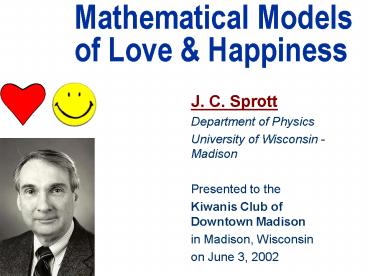Mathematical Models of Love - PowerPoint PPT Presentation
Title:
Mathematical Models of Love
Description:
Mathematical Models of Love & Happiness. J. C. Sprott. Department of Physics ... http://sprott.physics.wisc.edu/ lectures/love&hap/ (expanded version of this talk) ... – PowerPoint PPT presentation
Number of Views:38
Avg rating:3.0/5.0
Title: Mathematical Models of Love
1
Mathematical Models of Love Happiness
- J. C. Sprott
- Department of Physics
- University of Wisconsin - Madison
- Presented to the
- Kiwanis Club of Downtown Madison
- in Madison, Wisconsin
- on June 3, 2002
2
Disclaimers
Its Strogatz fault
This is not serious sociology
I wont get to the happiness part
3
The Mathematics
R is Romeos love for Juliet (or hate if negative)
J is Juliets love for Romeo
dR/dt aR bJ
a and b describe Romeos Romantic Style
4
Some Romantic Styles
- dR/dt aR bJ
- a0 (out of touch with own feelings)
- b0 (oblivious to others feelings)
- agt0, bgt0 (eager beaver)
- agt0, blt0 (narcissistic nerd)
- alt0, bgt0 (cautious lover)
- alt0, blt0 (hermit)
5
What about Juliet?
dJ/dt cR dJ
She has her own style
4 parameters with 3 choices for each gives 81
different romantic pairings
6
Both out of touch with their own feelings
0
- dR/dt aR bJ
- dJ/dt cR dJ
- Four subclasses
- b gt 0, c gt 0 (mutual love fest or war)
- b gt 0, c lt 0 (never-ending cycle)
- b lt 0, c gt 0 (never-ending cycle)
- b lt 0, c lt 0 (unrequited love)
0
7
Out of touch with their own feelings (continued)
b gt 0, c gt 0
b lt 0, c lt 0
b gt 0, c lt 0
War
Two lovers Love fest (or war)
Two nerds Unrequited love
Nerd lover Never-ending cycle
8
With Self-Awarenessand bc lt 0 (nerd lover)
a d lt -2bc1/2
a d lt 0
a d gt 0
Extremely cautious Rapid apathy
Somewhat cautious Eventual apathy
Overly eager Growing volatility
(The only equilibrium is apathy)
9
Fire and Water(Do opposites attract?)
- Take c -b and d -a
- Result depends on a, c, and the initial
conditions - Can end up in any quadrant
- Or with a steady oscillation
- But never apathy
10
Peas in a Pod(Are clones bored or blissful?)
- Take c b and d a
- Result depends on a, b, and the initial
conditions - Can end up in any quadrant
- Or at the origin (boredom)
- But no oscillations
11
Romeo the Robot(How does Juliet react?)
- Take a b 0 (dR/dt 0)
- dJ/dt cR dJ
- There is an equilibrium at J -cR/d
- Can be either love or hate depending on signs of
R, c, and d - Stable if d lt 0, unstable if d gt 0
- Her feelings never die
- No oscillations are possible
12
A Love Triangle
- Romeo has a mistress, Guinevere
- Guinevere and Juliet dont know about one another
- Romeo responds to each with the same romantic
style (same a and b) - Guineveres hate has the same effect on his
feelings for Juliet as does Juliets love, and
vice versa
13
Love Triangle Examples
14
Romeos Fate
- Averaged over all romantic styles (64
combinations of parameters) and 64 initial
conditions - 37 loves Juliet hates Guinevere
- 37 loves Guinevere hates Juliet
- 6 loves both (2 everyone in love)
- 6 hates both (2 everyone in hate)
- 14 apathy (10 everyone apathetic)
- Anything can happen!
15
Effect of Nonlinearities
Replace ax with ax(1-x), etc. (logistic
function)
ax(1 - x)
ax
x
16
One Chaotic Solution of Nonlinear Love Triangle
Strange attractor of love
17
Possible Further Studies
- What happens if Guinevere and Juliet know about
one another? - What happens if only Guinevere knows about
Juliet? - What happens if Juliet and/or Guinevere has
another lover? - What are the dynamics of a free-love commune?
- Is there an optimum pairing of romantic styles
that encourages success or portends failure?
If such problems interest you, lets collaborate!
18
Summary
- Love and happiness are wonderful
- So is mathematics
19
References
- http//sprott.physics.wisc.edu/
lectures/lovehap/ (expanded version of this
talk) - Steven H. Strogatz, Nonlinear Dynamics and Chaos
(Addison-Wesley, 1994) - sprott_at_physics.wisc.edu































